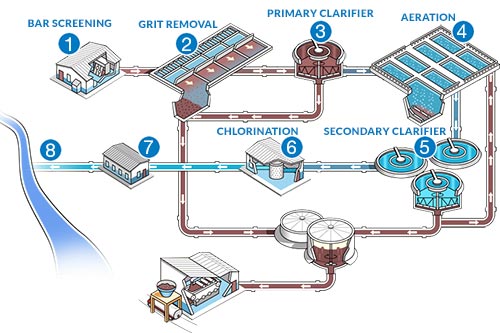Exploring Innovative Developments in Wastewater Technology
Exploring Innovative Developments in Wastewater Technology
Blog Article
Recognizing Wastewater Therapy Processes and Their Ecological Effect
The complexities of wastewater therapy processes play a pivotal duty in mitigating ecological obstacles related to water air pollution. Each stage, from initial to innovative treatments, is developed to attend to particular contaminants, eventually guarding both public health and wellness and marine communities. Despite technical developments in treatment effectiveness, significant challenges continue, including the administration of residual contaminants and the effects of nutrient overflow. As we explore the intricacies of these procedures, it comes to be vital to wonder about exactly how much present techniques can progress to satisfy the growing needs of sustainability and ecological preservation.
Summary of Wastewater Therapy
Exactly how is wastewater transformed right into a risk-free source for the setting? Wastewater treatment is a vital process created to get rid of contaminants from made use of water, thus protecting public wellness and shielding communities. This procedure starts with the collection of wastewater from domestic, industrial, and industrial resources, which is then directed to therapy centers.
At these facilities, numerous physical, chemical, and organic methods are employed to treat the wastewater. Consequently, biological therapies, such as activated sludge processes, make use of microbes to break down natural issue.
The treated effluent can be securely discharged into natural water bodies or recycled for irrigation and commercial functions, promoting source preservation. In addition, the treatment process generates biosolids, which can be repurposed as fertilizers or soil modifications, even more improving sustainability.
Phases of Treatment Procedures
The wastewater treatment procedure normally is composed of 3 main stages: initial, main, and secondary treatment. Each phase offers a distinctive function in lowering the pollutant load and ensuring the effluent satisfies ecological criteria prior to discharge.

The key treatment stage concentrates on the physical separation of suspended solids from the wastewater. With sedimentation, larger particles settle at the base of sedimentation containers, creating sludge, while lighter materials, such as oils and greases, float to the surface area and are skimmed off. This procedure dramatically minimizes the natural and inorganic tons in the wastewater.
Additional treatment is an organic procedure focused on more minimizing the focus of raw material. Different approaches, consisting of triggered sludge systems and dripping filters, use bacteria to metabolize natural toxins. This phase is crucial for attaining the essential biochemical oxygen need (BODY) decrease, eventually resulting in cleaner effluent all set for discharge or additional treatment. Each stage is important in safeguarding environmental and public wellness.

Advanced Treatment Technologies
Complying with the second therapy procedures, progressed therapy innovations play a crucial duty in additional improving the high quality of dealt with wastewater. These modern technologies are created to remove recurring impurities that are not properly gotten rid of during main and additional therapies, ensuring try this web-site the effluent meets stringent regulatory requirements.
Among the extensively utilized advanced treatment techniques are membrane filtering, reverse osmosis, and progressed oxidation procedures. Membrane layer purification, consisting of microfiltration and ultrafiltration, is effective in like this dividing great fragments, virus, and colloids from the water (Wastewater). Reverse osmosis uses semi-permeable membrane layers to get rid of dissolved solids, leading to premium water suitable for numerous applications
Advanced oxidation processes (AOPs) employ strong oxidants to weaken organic contaminants, including pharmaceuticals and personal treatment items that are immune to traditional therapy. These methods boost the biodegradability of complex substances, facilitating their removal.
One more significant technology is using biological nutrient removal processes, which especially target nitrogen and phosphorus, protecting against eutrophication in obtaining water bodies. Generally, advanced therapy innovations are important for accomplishing higher degrees of filtration, advertising water reuse, and guarding public wellness while addressing the challenges related to wastewater management.
Ecological Advantages of Therapy
Many ecological advantages occur from effective wastewater treatment processes that add to ecosystem health and sustainability. Mainly, these procedures substantially lower the release of unsafe toxins into natural water bodies, which helps maintain water environments. By removing contaminants such as heavy metals, nutrients, and pathogens, dealt with wastewater minimizes the risk of waterborne illness and advertises biodiversity in marine environments.
Additionally, wastewater treatment facilities frequently employ innovative technologies that make it possible for water recycling and reuse. This method not just preserves freshwater sources but also decreases the demand on natural water materials. Boosted nutrient removal from wastewater can also stop eutrophication, a process that brings about algal blooms and subsequent oxygen exhaustion in marine systems.
Furthermore, reliable therapy procedures can minimize greenhouse gas exhausts, particularly methane and nitrous oxide, which are commonly released during without treatment wastewater disintegration. By recording and using biogas from anaerobic digesters, centers can transform waste into eco-friendly energy, thereby contributing sites to a decrease in nonrenewable fuel source dependence.
Obstacles and Future Patterns
While the environmental benefits of wastewater treatment are clear, several difficulties linger that hinder optimal outcomes in this area. One major problem is aging facilities, which commonly results in inefficiencies and boosted functional prices - Wastewater. Lots of treatment plants were developed years ago, and their abilities do not align with contemporary demands, which include more stringent regulative criteria and greater quantities of wastewater because of urbanization
Looking in advance, there is an expanding focus on source recovery and round economic climate principles within wastewater therapy. Developments such as anaerobic digestion, which can generate biogas, and advanced filtering modern technologies are getting grip. These methods not just improve therapy performance but additionally promote sustainability.
Ultimately, addressing these difficulties needs cooperation among stakeholders, investment in innovation, and a commitment to ongoing study. By embracing these fads, the wastewater therapy field can develop to satisfy the demands of a transforming setting and society.
Verdict
In verdict, wastewater treatment processes play an essential role in boosting environmental top quality and public wellness. The multi-stage treatment framework, combined with sophisticated innovations, effectively minimizes air pollution and promotes lasting water monitoring.
Report this page